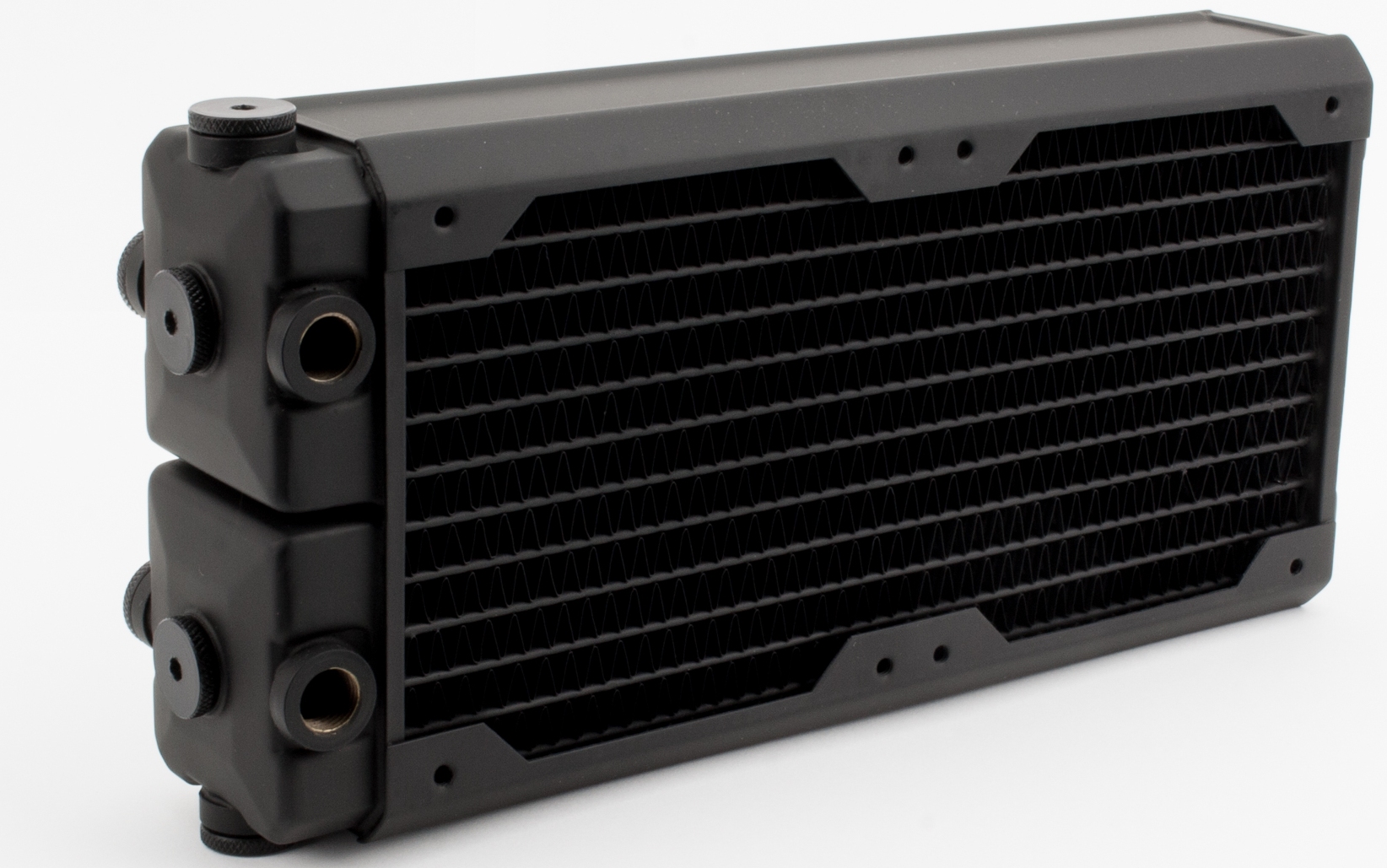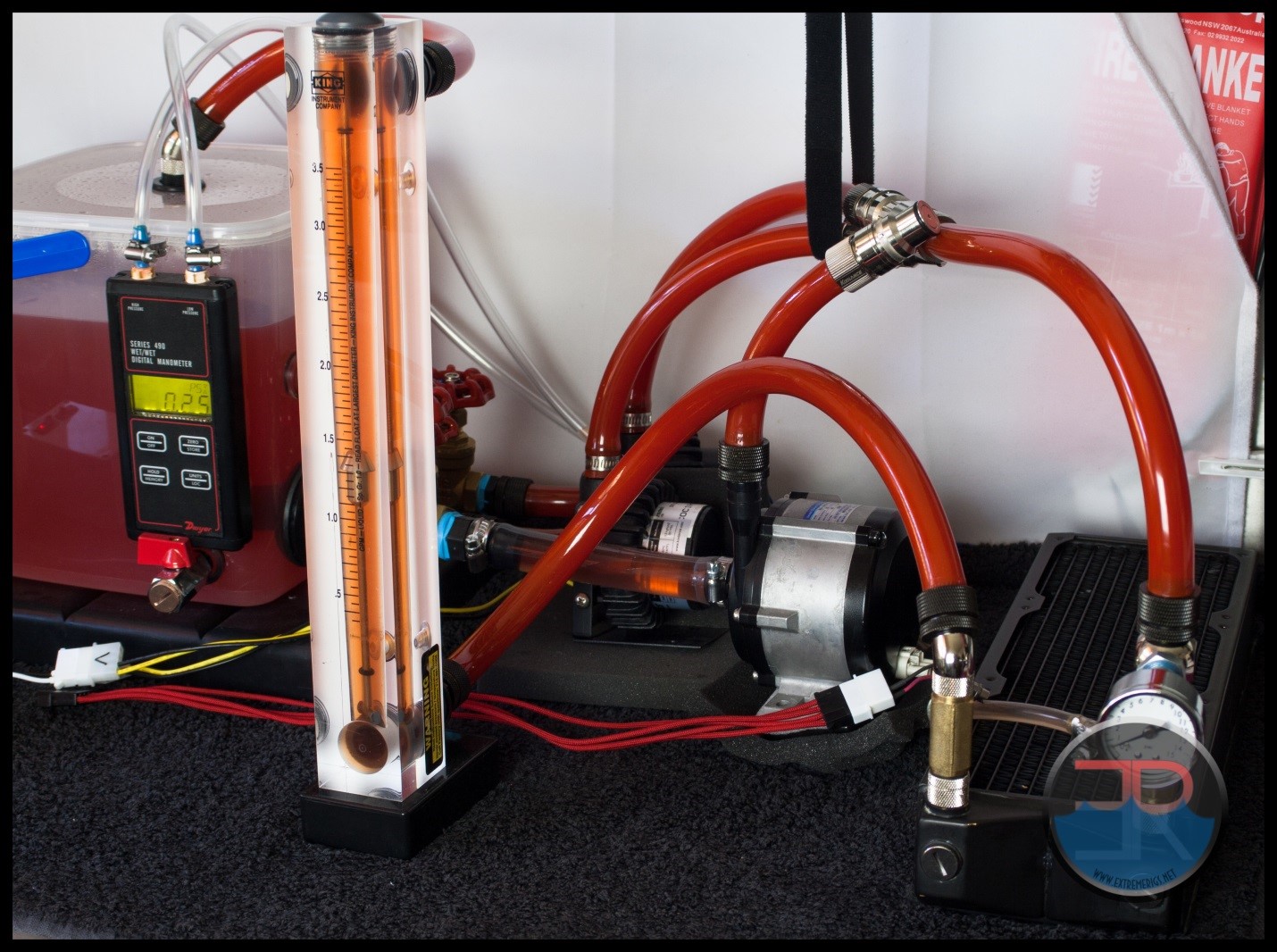The Data
All the testing was performed with the exact same equipment, using the exact same methods as was used in the 360mm round-up so I have decided to keep this review uncluttered by keeping our testing methodology, test set-ups and equipment used in a single location. To see exactly how the tests were carried out, details of the test set ups and equipment used, please head over to the RRU Test Setup page.
Restriction Test
It’s generally agreed that radiators are one of, if not the least restrictive components in the water cooling loop. There are some exceptions however, so this must still be verified through testing:
The above photo is for referencing the restriction test bench The SR2 240 MP is not loaded so please disregard the data in the picture as it does not relate to the its test results.
Here is the raw data at the tested flow rates, displaying the measured Differential Pressure across the radiator as flow rate was increased.
 The table numbers indicate that this SR2 is a very low restriction radiator. However numbers in isolation can only tell half the story. By plotting against other components it more easily shows the whole story.
The table numbers indicate that this SR2 is a very low restriction radiator. However numbers in isolation can only tell half the story. By plotting against other components it more easily shows the whole story.
I have decided to use a HeatKiller 3.0 CPU block as the reference in this next plot for two reasons. Firstly there is no chance of the plot being cluttered by curves overlapping and secondly it gives a reference point against a fairly common loop component of average restriction.
As with all previous radiator restriction plots, I have limited the maximum flow rate displayed to 2.0 GPM as I suspect there are very few systems that operate above 2.0 GPM. For more information on how to read a restriction plot check out our guide.
 This plot confirms the SR2 240 MP as a low restriction radiator, extremely low I would even venture to say.
This plot confirms the SR2 240 MP as a low restriction radiator, extremely low I would even venture to say.
The next three plots show the restriction level at three different flow rates compared to the other 240mm radiator that has been tested so far. We consider the chosen GPM rates to represent systems which have low, medium and high flow rates.
 Clearly the SR2 MP has the lower restriction level of the 2 rads and is due to it’s much larger tube size. This is not to say the EK XE is overly restrictive, just that the SR2 is much less so.
Clearly the SR2 MP has the lower restriction level of the 2 rads and is due to it’s much larger tube size. This is not to say the EK XE is overly restrictive, just that the SR2 is much less so.
This next plot shows both 240 rad’s results for the full range of the flow meter we use for testing the restriction level.
 To give a bit more perspective, lets take a look at both rads data again in table format but in a first let’s start to compare some different size rads for restriction levels.
To give a bit more perspective, lets take a look at both rads data again in table format but in a first let’s start to compare some different size rads for restriction levels.
We’ll stick to only the 1.0 GPM flow rate to keep some sort of a constant, but into the mix we’ll put data from an assortment of radiator sizes.
This has the very lowest and the very highest we have recorded as well as a mix of other rads, mostly from the same manufacturers.

So in the bigger picture of radiator restriction the SR2 240 MP does indeed have a very low restriction level.
Onwards to Thermal Performance!















Maybe slightly disappointing thermal results, but not a deal breaker. Swarf in rad not a deal breaker either. Flexibility of ports, flexibility of use/fan rpms and overall quality mean that this is still a very good radiator. Again: great test. Now, please get more 240 results!
Often written or said in radiator reviews, “Since the XXX size of brand X radiator has shown XYZ level of performance, one should expect like performance from up-size XXX (or) down size XXX.” If the ratio of/comparable performance of the SR2 240 MP falls short of the SR2 360 MP, should we expect the 480 to provide an additional boost in performance over the 360 or similar performance to the 360? Given what the test results of the 240 tell us, how can an answer to either possibility be justified?
Not sure quite what you’re trying to say Questors – can you explain again?
The 240 performs at about 70% of a 360 when using an equal heatload. However it is running more efficiently as an equal heatload equates to a higher delta T. The 240 *should* of course be 66% of the the 360 and I do believe that it would give us that result if we kept a constant delta T instead of a constant heatload.
So to answer the question – should the 480 provide an additional performance boost over the 360? Absolutely – yes it should. As to how much – we would expect the ideal 33% more cooling ability when measuring a constant delta T, however for a constant heatload you would some efficiency because the delta T would be lower. So to guess – somewhere between 25-30% better cooling.
Does that answer the question?
This was the basis for me asking the question: “However, the thermal Test conditions did not favor the 240mm variant quite as well as the 360mm. The consistency was still there but performance was weaker when compared to the same competitor.”
To me this meant the performance of the SR 240 vs the XE 240 was less proportionate to the SR2 360 results against the XE 360.
Your response clears things up for me – “a constant delta T instead of a constant heatload”
[…] EK XE 240 Radiator Hardware Labs SR2 240 Radiator […]
Comments are closed.